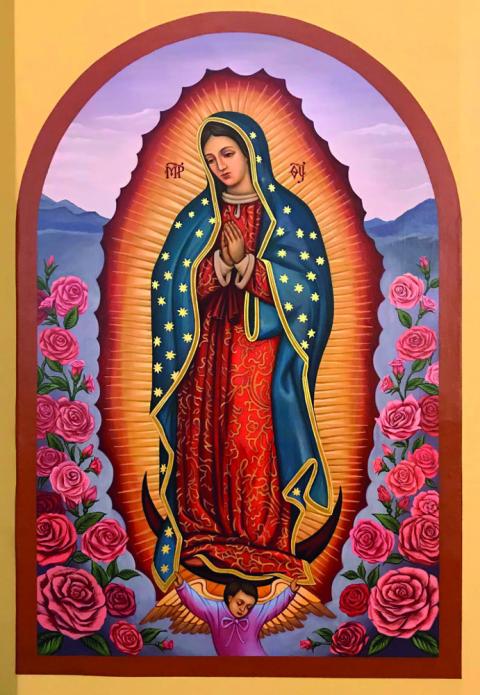
This icon of Our Lady of Guadalupe is in St. Mary Parish in Whiting, Ind. It is the first parish in the Eparchy of Parma, Ohio, to commission an icon of Our Lady of Guadalupe. It was painted last year by iconographer Christine Uveges. (CNS/Laura Ieraci, Horizons)
Renowned for its reverence for ancient tradition, the Byzantine Catholic Church is rather unhurried to add new feasts to its liturgical calendar.
However, in the past 20 years, the Byzantine-Ruthenian Catholic Church in the United States has added at least four new feast days, namely for three 20th-century martyred bishops — Blesseds Paul Gojdich, July 17, Basil Hopko, July 23, and Theodore Romzha, Oct. 31 — and one feast dedicated to the mother of God, Our Lady of Guadalupe, Dec. 12.
While Our Lady of Guadalupe has been on the Byzantine Catholic calendar since 1999, many Byzantine Catholics still are unaware that this feast, largely perceived as a devotion of Latin-American Roman Catholics, also is theirs to celebrate.
Mary appeared to St. Juan Diego at dawn Dec. 9, 1531, on Tepeyac Hill, in what is now northern Mexico City. She appeared to Juan Diego twice more, and the last time, on Dec. 12, filled his "tilma," or cloak, with roses. When he emptied his cloak of the roses, he found that it bore her image. The cloak is enshrined in the Basilica of Our Lady of Guadalupe in Mexico City.
St. Mary Parish in Whiting, Indiana, has taken the lead in the Eparchy of Parma in promoting this Marian devotion. The parish commissioned a mural of Our Lady of Guadalupe last year.
The eparchy includes Byzantine-Ruthenian Catholic parishes in Illinois, Indiana, Iowa, Kansas, Michigan, Minnesota, Missouri, Nebraska, North Dakota, South Dakota and Wisconsin and most of Ohio.
The story that led to the feast of Our Lady of Guadalupe being added to the Byzantine Catholic calendar is one of an American archbishop's awakening to the need for the Byzantine Catholic Church to be engaged in the evangelizing mission of the church in North America.
During a pastoral visit to Mexico in January 1999, St. John Paul II named Our Lady of Guadalupe as the patroness of the Americas, and declared that Dec. 12 would be celebrated as the feast of Our Lady of Guadalupe in all the dioceses of the Americas.
Also, in this context, St. John Paul declared her the patroness of the new evangelization, calling the church in the Americas to a deeper commitment to proclaiming the Gospel and to the conversion of nonbelievers.
Archbishop Judson Procyk of Pittsburgh, then head of the Byzantine Catholic Church in the United States, traveled to Mexico for the pope's visit and attended the papal Mass at the Basilica of Our Lady of Guadalupe.
One of the archbishop's theological advisers later recounted that, upon Procyk's return from Mexico, he excitedly remarked, "The Guadalupana is ours."
He added her feast day to the Byzantine Catholic calendar by circulating the related decree sent to all the bishops from the Congregation for Divine Worship.
Procyk reportedly encountered something strangely familiar in Mexico City in the image on the tilma: In the mother of Americas, he found the mother of all Byzantine Catholics.
The mother of God appearing to St. Juan Diego has much in common with the Byzantine tradition of a miraculous icon that comes to the lowly, such as the Icon Not Made by Human Hands — an icon of Christ — and the icon of Our Lady of Mariapoch.
In appearing as Our Lady of Guadalupe, Mary is with child — represented by her belt worn high on her abdomen. It is the only recognized Marian apparition in which she is pregnant. The detail is particularly significant in the Byzantine tradition, which emphasizes Mary's maternity as "Theotokos," a term which means "she who bore God."
Advertisement
As devotions go hand-in-hand with liturgical expression in the Christian East, Fr. Maximos Davies of Holy Resurrection Monastery in St. Nazianz, Wisconsin, wrote a Byzantine Catholic office for Our Lady of Guadalupe, which draws heavily on Byzantine tradition to cast a new light on the miracle of Guadalupe.
For instance, one of the hymns in the "aposticha," or set of hymns, for the feast takes up the traditional vespers reading for the mother of God, in Chapter 9, verses 1-11, of Proverbs, that depicts Mary as Lady Wisdom, calling all people to feast on her Son at the eucharistic liturgy.
At the same time, the office honors the particular message of hope that the mother of God conveys specifically to the people of the Americas:
"Know all my smallest and most humble children that I am the Virgin who gave birth to God, The Word through whom everything has the breath of life! He has given you to me as your mother, all you peoples of the Americas; I will hear all your weeping and your complaints; I will heal all your sorrows, hardships and sufferings. Repent and believe in the Gospel! And together we will worship the Lord and lover of mankind!"
Byzantine Catholics in North America, who have adopted this feast and include this devotion in their common life of prayer, can contemplate a timely question: How does this miraculous icon of Our Lady of Guadalupe call us to engage in the new evangelization on this continent?
- - -
Fr. Summerson, a priest of the Eparchy of Parma, is a regular contributor to Horizons, newspaper of the eparchy.







